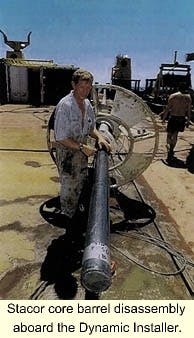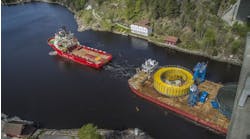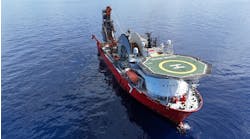Soil investigations for the recent Kuito development off Angola were conducted using an innovative piston corer designed by Geocean Solmarine. The large diameter, true stationary corer system (Stacor) was deployed from the project leader SBM's dynamically postioned (DP) vessel, the Dynamic Installer, to collect samples over 200 meters long at the intended floating production, storage, and offloading (FPSO) and catenary anchor leg mooring (CALM) anchor point locations. Water depths were around 430 meters.
Results of the subsequent analysis were used to optimize the suction anchor pile design - these piles were subsequently installed successfully to their targeted penetration depths, and within their installation tolerances. Altogether, the Dynamic Installer fitted 12 suction piles for the spread-moored FPSO and six for the CALM buoy.
A joint paper by authors from SBM, Kuito operator Chevron, and Geocean Solmarine at this March's Offshore West Africa conference in Abidjan included details of the Stacor sampling exercise. The corer had previously been used to recover high quality cores, some over 33 meters long, in water depths beyond 6,000 meters, primarily for geological research purposes. For Kuito, it was deployed to collect samples up to a maximum depth of 21 meters below the mudline. A continuous sampling operation recovered six piston cores at the CALM anchor locations and nine at those for the FPSO anchors.
According to the authors, the Stacor is unique in the quality of cores that it obtains. This is due largely to the stationary piston inside the core tube which helps to limit friction, and thereby also minimizes disturbance, during penetration into the seabed. Claimed recovery for the device in normal conditions is 98-99%. It has three main components:
- Weight stand which can be adjusted from 0.5 tons up to 9 tons, according to anticipated soil conditions and penetration needs
- Core tube comprising an assembly of 1-meter-long steel tube elements and including a cutter and core catcher at the lower end (the tube has an inner liner made of PVC to aid sample retention following recovery)
- Seabed frame through which the core tube is run (the frame rests on the seabed while the Stacor is in operation, and is then used as a fixed reference point for the core tube's piston).
The tube is normally assembled horizontally on the deck or on the ship's side, then raised vertically for connection to the frame and the weight stand, before finally being lowered to the seabed. For the Kuito investigations, the vessel's crane was used to raise the 20-meter-long barrel with the frame attached. The weight stand was then connected to the core tube in an outrigger frame alongside the vessel.
The assembled Stacor was then connected to the vessel's main winch cable and lowered to the seabed. About 100 meters above the seabed, lowering was suspended while a messenger line sent along the cable was used to activate the trigger mechanism (the latter is activated near sea-bottom to avoid premature triggering of the Stacor). When the corer's bottom reaches a point 10-20 meters above the seabed, it is triggered automatically using a clump weight that touches the sea bottom.
Following penetration, the Stacor is recovered to the surface, the core tube is disconnected from the weight stand and is then lowered horizontally back onto the deck. The next step is to disassemble the core barrel in 1 meter sections, and 1-meter-long cores are then retrieved in their PVC liner.
For Kuito, Geocean also managed 10 associated piezocone penetration tests at various proposed anchor locations. Subsequent soil analysis revealed that the soils could be divided into two distinct strata, with the change occurring at a depth of between 5.5 meters and 12 meters, corresponding to a marked reflector on the geophysical data. Cyclic shear strength tests indicated that no degradation would occur under cyclic loading. Accord ing to the authors, the success of the subsequent pile installations demonstrate that the Stacor sampling method is appropriate and cost-effective for soft soils in these water depths.
IFP develops two seminars on management and reform strategies
Institute Francais de Petrole (IFP) is organizing two seminars for the oil and gas industry.
- The first seminar will be held on May 21 to June 3 in Paris, France and will be an international training program on "Reform Strategies and Private Participation in the Oil and Gas Sector." The aim of this two-week training course will be to facilitate the understanding by industry and government officials of key petroleum and gas sector policies and to transfer the key preconditions, the policy concepts, and the savoir-faire under which the oil and gas sector could be reformed and, if so decided, a privatization process formulated and implemented.
The course will be based on value chain concepts and value creation so that industry managers and government officials will obtain a complete understanding of how decisions relative to policies are taken and how actions at one step of the oil or gas chain affect performance in other steps. Additionally, the course will focus on the general policy principles of the reform as well as a wide range of practical cases that will show the decision makers those available options that will facilitate adapting the principles to the circumstances prevailing in their individual country.
- The second seminar, "Oil and Gas Manage ment - Executive Session", will be held on June 25 through July 7, also in Paris. This seminar is specifically designed for executives and senior managers in the oil, gas, and petrochemical industries, and related activities. The seminar plans to combine IFP's expertise with that of high-level industry specialists and executive, and of professors from top management schools. The seminar will address specific factors influencing the upstream and downstream oil and gas sectors and examines management challengies arising from the interdependence of these sectors.
The program is structured around three core disciplines: business environment, oil and gas perspective, oil and gas management, and strategic finance and economics.
IFP has already lined up strong speakers for the seminar, including Vittorio Mincato, CEO of Italy's ENI, Christophe de Margerie, President TotalFina Exploration and Production, Frank Chapman, President of BG International, Pieter Berkhout, Country Chairman for Deutsche Shell, and David Law-Smith, Former Chairman and CEO of Caltex.




